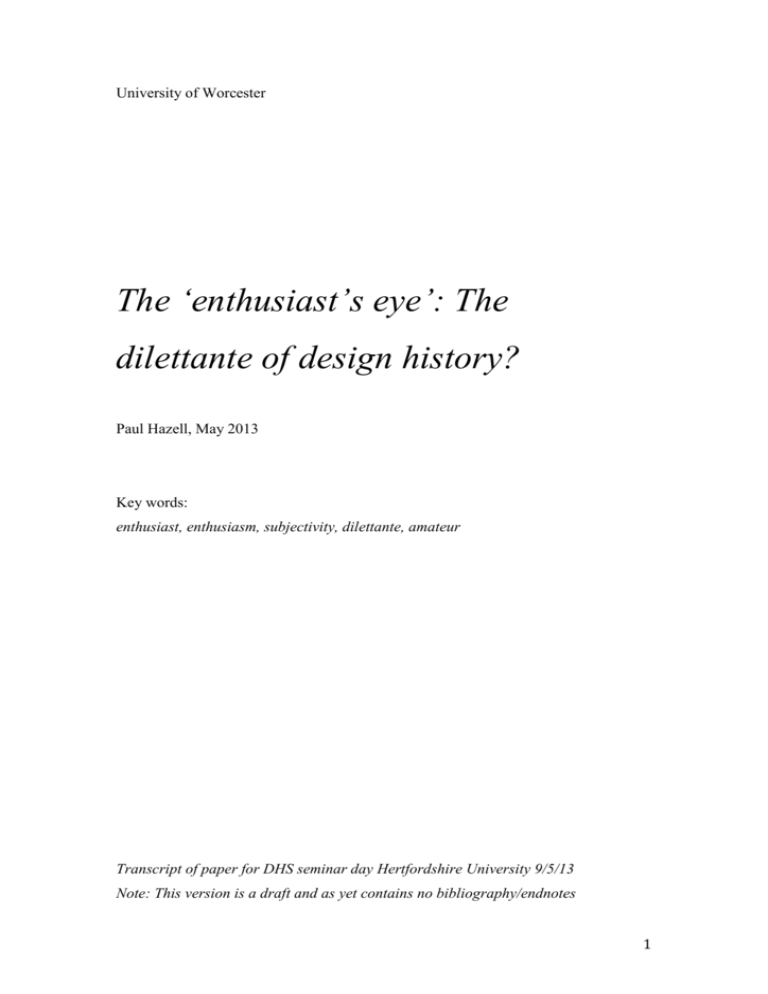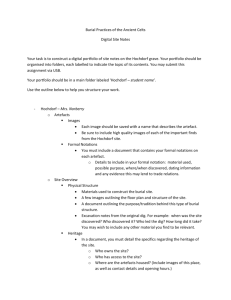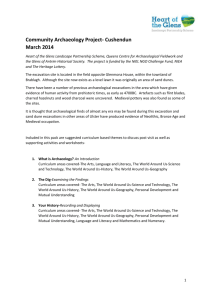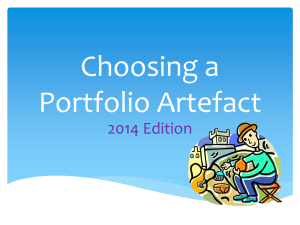`enthusiast`s eye`: The dilettante of design history?
advertisement

University of Worcester The ‘enthusiast’s eye’: The dilettante of design history? Paul Hazell, May 2013 Key words: enthusiast, enthusiasm, subjectivity, dilettante, amateur Transcript of paper for DHS seminar day Hertfordshire University 9/5/13 Note: This version is a draft and as yet contains no bibliography/endnotes 1 Abstract Individuals and enthusiast groups dedicated to particular aspects of material culture frequently emerge and manifest themselves in a variety of ways; whether it be car clubs, individuals collecting particular items they take an interest in, or re-enactors interacting with objects from the past. These interested groups or individuals can hold considerable knowledge and expertise about an artefact and its history, but the term ‘enthusiast’ carries with it connotations of the passionate amateur and by implication unstructured knowledge, subjectivity, selectivity and nostalgia. Design History is a relatively young field that has worked hard to become established as a discipline in its own right and build a reputation for rigour. Words such as ‘enthusiast’ and ‘amateur’ can be seen as pejorative terms with regard to the study of Design History that academics may feel they want to distance themselves from. However, if we are too ready to link the ‘enthusiast’ to ideas of ‘celebration’ or ‘niche interest’ we may be ignoring factors that help explain the success of some artefacts in relation to others, as well as underestimate the value of archival material held in private collections, which can be rich sources for design history research. This paper therefore asks can ‘the enthusiast’s eye’ be used as a starting point for grappling with the often-complex script some material culture creates by examining the enthusiasm an individual or a group may have for a particular period or artefact and integrating this with an appropriate methodology? What drives this devotion for particular artefacts, and if better understood, can this enthusiasm help provide a bridge between subject and object? 2 Introduction [intro SLIDE] As Jo Turney declared in the first talk today ‘its all about me’. I hope you’ll forgive me giving you a personal, and therefore subjective, introduction as a way of providing some context for my talk: ‘the enthusiast eye: The dilettante of design history?’ My background is based in practice: Initially technical illustration and later information design, a discipline arguably at the more objective end of graphic design where user testing is the norm and evidence based design solutions are considered best practice. I have also worked in higher education for nearly 20 years teaching many aspects of graphic communication where both the students and sometimes the teacher are grappling not only with the craft but also the many subjective discussion points of semiotics that inform much of visual communication. A number of years ago my work took a new turn however when I became interested in the idea that much of our reaction to design as users and consumers is highly subjective – mine included. This ranges from the active disliking of particular designs (‘this chair is uncomfortable’, ‘that’s an ugly car’), through invisibility (‘did you notice the cutlery you used to eat your dinner last night?’), to vague preferences (‘I prefer the green one’) and onto dedicated enthusiasm for particular artefacts (‘The Spitfire is an iconic aircraft’). [SLIDE] A triangle of interests exists in relation to the interpretation of materiality where I am able to be an actor/participant in each: Designers, Users & Design Historians. These groups, or modes of activity, exhibit differently nuanced behaviour in relation to their engagement in design, its implementation, consumption and history. Those in design practice are often extremely enthusiastic about what they do. There is a strong sense amongst graphic designers for example that if you are not excited about your latest design you are not doing your job properly. Designers in other disciplines have expressed similar views during interview. Users on the other hand often interact with designed materiality (i.e. things), without realising they have done so. Occasionally however, users will become aware of an artefact as its function is augmented by symbolism and meaning. This can manifest 3 itself as an affection or appreciation of a particular piece of design through to what might be described as ‘full-blown enthusiasm’. Somewhat outside todays talk but worth noting nonetheless is that this is the domain in which branding powerfully operates. These first two groups, designers and users, seem both able and willing to accept enthusiasm into their understanding of design. The third group, Design Historians, are much more reluctant as it appears counter to the scholarly traditions of taking an objective view. This downplays, or at worst ignores, the visceral impact designed artefacts can have on individual’s lives. [blank SLIDE] When first becoming seriously engaged in Design History what surprised me was not what examples of material culture were studied, but what seemed to be overlooked. Not so much the artefacts themselves, but the notion that meaning is only ever attached to objects, where a practicing designer might argue the artefact itself can convey ideas beyond its function – sometimes intentionally, sometimes not. Is the transparency of much of material culture to blame for the limited research in relation to enthusiasm and design, the subjectivity of the question itself or some other factor? Examining the influence of material culture and the elevated status of some artefacts has emerged as a research focus from my own enthusiasm for a particular type of artefact, in my case the motor vehicle, especially British vehicles, and the Land Rover in particular. This has led me to undertake a PhD exploring that most subjective of historic terms: Iconic Design. [SLIDE] Now if you have never owned a utility Land Rover (known as a Defender since 1990) you will be unaware, or may not even care, that most drivers of Defenders wave at each other when they pass. [SLIDE] This is unusual in modern motoring and there is a protocol of course; drivers of Defenders owned by the Army, farmers or the electricity board etc. rarely wave. However private individual’s who own their Defender usually do. This begs an obvious question: why? Is it because the first group (soldiers, farmers and contractors) see their Land Rover as purely a workhorse, a tool to get the job done? The second group differ, as they have been motivated in some way to spend their own money to buy a 4 capable but rather thirsty, noisy & slow vehicle but nevertheless seem to be saying with a simple wave to a fellow Land Rover owner ‘I get it too’. There is, it seems, a desire to share their enthusiasm with likeminded strangers. Such observable manifestations of enthusiasm in relation to materiality are surely worthy of study? [SLIDE] Now it is at this point I should say I am a self-confessed Land Rover ‘geek’ (you may have even worked this out already) – or possibly we should use the more acceptable term ‘enthusiast’. Over the years I have collected and restored many examples of various vintages and types. This personal, but far from unique, interest had until recent years not impacted significantly on my ‘day job’ as a designer or academic, and like many enthusiasts I’d kept pretty quiet about my private obsession. It formed the parallel world of ‘hobbies and interests’ where many of us spend considerable time and money and where one (though unpaid and without obligation) often feels highly motivated and deeply engaged in a particular pastime. Are there, therefore characteristics particular to some artefacts that mean an inanimate object can become a fascination to some, and what might this tell us about material culture as viewed through the ‘enthusiasts eye’? [blank SLIDE] It is clear individuals and enthusiast groups dedicated to particular aspects of material culture frequently emerge and manifest themselves in a variety of ways; whether it be clubs, individuals collecting particular items they take an interest in, or re-enactors interacting with objects from the past. These interested groups or individuals can hold considerable knowledge and expertise about an artefact and its history. However, the term ‘enthusiast’ carries with it connotations of the passionate amateur and by implication unstructured knowledge, subjectivity, selectivity and nostalgia. Words such as ‘enthusiast’ and ‘amateur’ have become pejorative terms that Design Historians may want to distance themselves from. The need for a scholar to be objective can make it difficult to put aside potential prejudices about the nature of enthusiasm, but doing just this is necessary if we are to better understand the nature of enthusiasm in relation to material culture. If too ready to link the ‘enthusiast’ to ideas of ‘celebration’ or irrelevant ‘niche interests’ design historians are ignoring factors 5 that can help explain the success of some artefacts in relation to others as well as underestimate the value of archival material held in private collections that can be rich sources for Design History research. This is not an argument for the Design Historian to necessarily be an enthusiast for the artefact being studied – in terms of objectivity it could be argued that it may be better if they are not. However, to acknowledge that ones own research, at least initially, might be driven by enthusiasm for a topic may mean we need to reappraise the word and examine its merits rather than pretend that our enthusiasms don’t influence our research. I would go further and suggest that our enthusiasms, or the examination of other peoples or groups, can provide an alternative starting point for research that from the outset acknowledges the complex personal relationship we have with objects. [SLIDE] Them and us: How might the ‘enthusiast’s eye’ be useful to the design historian? To imagine all enthusiasts, collectors and amateur historians are dilettantes with no real commitment or structured knowledge may mean we neglect a useful resource for our research and often underestimate the enthusiast and what, sometime unwittingly, they reveal about material culture. The enthusiast can make the transparent, visible, by selectively highlighting examples of material culture, and as a by-product of their personal interest, encourage us as academics to look again at an artefact and consider its significance. [SLIDE] Interface designers often talk about the desirability of transparency in design, the idea that when using for instance, a well designed website or software application we are only really aware of the content, not the means of accessing it through the use of menus, icons and a cursor. We look through these interface devices as if they were transparent so we can intuitively engage in the content. Similarly much of what we take for granted in modern life is only possible as a result of design and the majority of these artefacts we interact with are ignored by the user most of the time, at least at a conscious level, until that is, there is either a problem or they are absent. [SLIDE] If you are not an enthusiast for instance you may only give your car 6 conscious thought if it fails to start in the morning or as a result of this it has to go to the garage and you need to organise alternative transport. [SLIDE] Or at a more mundane level the importance of a pair of scissors only becomes apparent when we can’t find them. Heidegger’s concept of ‘ready-to-hand’ explains how we take these transparent artefacts for granted until they break or go missing but says less about why it is possible to become enthused by the more ‘visible’ manifestations of material culture. [blank SLIDE] Enthusiasts, or ones personal enthusiasms, can flag-up areas of potential research design historians might at first consider unworthy of examination. Probably rightly, as historians we are likely to discount individual eccentric collectors of the mundane such as traffic cones or tea cosies. However if there is an observable, or even measurable, clustering of subjective personal opinions this pattern or phenomenon may be both significant and revealing if examined. It is not so much subscribing to ‘the wisdom of the crowd’, an approach an academic is likely to resist, but being aware that a group or an enthusiastic individual may highlight an aspect of material culture previously ignored or undervalued and therefore provide a useful starting point for new research. [SLIDE] To give an emerging example: one might examine 3D printing and the growing communities of on-line enthusiasts who are beginning to create and share data files of virtual objects that can now be made physical using the new technology. This type of technology is likely to significantly change our relationship with material culture in much the same way the Internet has changed our relationship with information. These enthusiast groups, though niche, highlight this emerging shift in our interaction with materiality in a concentrated form. The design historian can then look for historic parallels in the democratisation of design to better explain the emerging phenomenon and its possible consequences. 7 [SLIDE] Can enthusiasm (i.e. emotional thinking) lead to objective investigation? Direct experience of, or interaction with, an artefact leads to a different and often more profound understanding of the object. [SLIDE] It is rather a cliché but the Chinese proverb below goes some way to explaining the advantage of this direct interaction: What I hear I forget, what I see I remember, what I do I understand. Experimental archaeologists have known this for many years and regularly reconstruct historical artefacts or whole environments to better understand their use and limitations. Similarly anthropologists will immerse themselves in an environment or culture for long periods for similar reasons. Yet Design Historians infrequently spend extended periods of time using the artefact they are studying – despite, arguably, the relatively easy access to many of these items. Interacting with the artefact is usually fundamental to the enthusiast however. For many classic and vintage car enthusiasts for example it is not enough to only study the vehicle and its history. They want to own it, use it and experience how the artefact feels in use. This visceral interaction, though subjective and hard to define, can be a starting point for understanding the characteristics of an emotive artefact beyond the theoretical and inform our understanding of why a design ultimately carries its particular value complexes. [SLIDE] This use of an historic artefact can also lead to a change in the way it is perceived. The object moves out of potential obsolescence or being perceived as a static museum piece, to become an object inhabiting the world now and our understanding or perception of it changes as a result. To see an Edwardian car on a modern road for example shifts ones thinking about its place in history. The exposure of the occupants to the elements, the smile or grimace on their face depending on the weather conditions, the slowness (or sometimes surprising speed), the smell, the noise all challenge the bystanders received understanding of ‘vintage’. This expanding of ones perception to embrace the subjective can also be true for the design historian if they interact with an artefact directly. This may then prompt new questions and lines of investigation into material culture. 8 [SLIDE] Like many I am sure, I have spent a great deal of time in museums looking at exhibits and using archives. To visit the Imperial War Museum at Duxford and see an aircraft such as the Spitfire ‘in the flesh’ gives an enhanced, but subjective, understanding of the plane. To see and hear one fly is a different sensory experience again. Several years ago I unexpectedly saw a lone Spitfire display overhead and I was surprised at how moved I felt. Yet this was not nostalgia, as I had no personally experience of the events of WWII (being born in 1969). To see others also stop what they were doing, look up and quietly watch this visitor from the past was revealing. Not in relation to its war time history necessarily, but the Spitfires cultural significance since. [SLIDE] Approaches to engaging with enthusiasts Viewing material culture through the enthusiast’s eye may provide a new or additional perspective to the design historian. Enthusiasts can however be highly selective both with regard to historic periods as well as the particular artefacts they engage with even if their interests are diverse and the knowledge often considerable. So for example you will find individuals who enthuse about a very particular type of artefact, a specific car for example. But equally you will find enthusiasts focusing on a range of related artefact – whether it be valve radios or old garden implements. The borders of an enthusiast’s interests may be affected my many factors: budget, availability of examples, background etc. This means the expertise and artefacts both individuals and enthusiast groups hold is often a mosaic of specialist interests where the individual pieces that make it up may contain vast amounts of detail and archival material but other pieces required to construct the over-all picture are missing altogether. The enthusiast may be unaware or downplay the significance of these missing pieces and wish to expand their narrative for a given artefact further than the evidence can support. This is where the objective historian – if there really is such an individual – can help. The use of techniques such case study and stakeholder interviews when combined with appropriate methodologies such as Actor Network Theory, Phenomenology, Script Analysis and Domestication Theory can be particularly helpful in further 9 bridging the gap between subjectivity and a more evidence-based objectivity while still acknowledging the complexity of the relationship. Methods of accessing enthusiast’s expertise is also worthy of consideration. As distinctions should be made between types of enthusiasts, as for every genuine amateur expert there are likely to be dilettantes who will profess greater knowledge than they possess or exaggerate the importance of an artefact they have a particular interest in or fondness for. There has been a proliferation of special interest web forums for instance and inevitably many contain much content that is inaccurate, ill informed and even misleading at times. However if used critically they can still be a valuable resource particularly if exploring a very specific question or watching a discussion trend or activity. Clubs and societies are often a preferable starting point. Finding and contacting organisations dedicated to even the most obscure of artefacts has become simpler thanks to the Internet, and indeed made it easier for such groups to exist. More established clubs and societies often have well developed archives and individuals with particular area of expertise who are often very willing to help researchers. Larger clubs will at times publish works relating to their area of interest and these can also reveal useful detail for the design historian. [SLIDE] Recently as part of research for a book chapter on the Ford ‘Model T’ I contacted the UK owners club, initially to check dates and locations of events with the organisations archivist. As a result of conversation I was put me in touch with an owner local to me so I could photograph an example of the car. This in due course developed into an extended conversation with the owner and a journey around county lanes in a 1915 ‘Model T’ where first-hand experience greatly enriched my understanding of the vehicle and the impact it had in the early days of increasingly democratised motoring. Without engaging with enthusiasts in this way my research would have been much the poorer. [blank SLIDE] Conclusion I am still in the early stages of examining enthusiasm in relation to material culture, and it seems there is much to investigate; yet there is still only a small and rather scattered collection of research relating to design and the enthusiast (and the word is seldom mentioned specifically). Bjornar Olen’s 2010 book ‘In Defence of Things’ explores many of the issues relating to the ontology of objects in an accessible and 10 engaging way. Interestingly though Olsen is an archaeologist rather than a design historian, and as we have seen, this is a discipline that seems more willing to interact with historic objects to better understand there significance and the consequences of their use. More recently still Kjetil Fallan’s article for the last issue Journal of Design History entitled ‘Kombi-Nation: Mini Bicycle as Moving Memories’ explicitly explores personal engagement on the part of the design historian with objects. He states ‘Historians should not shun subjectivity and personal experience, but rather investigate its methodological and historiographical potential’. This recognition of the potential for the personal in design history is thought provoking and highly pertinent with regard to the place of the enthusiast in material culture. Increased interest in the interplay between enthusiasts and artefacts may be emerging, whether it is the design historians themselves using their own areas of enthusiasm as a starting point or exploring the focuses of special interest groups. There is also an increased willingness to critically evaluate such subjective, but popularly understood terms as ‘iconic’, ‘classic’ and ‘enthusiast’ in an academic setting (as witnessed by events such as today). As a designer I am used to the idea that the user should never be ignored. If the enthusiast is a user of historic artefacts perhaps the time is right for design historians to incorporate the subjective into their analysis and grapple with the consequences as an additional means of understand our complex relationship with material culture. [SLIDE] 11






